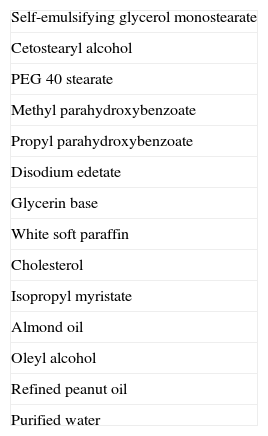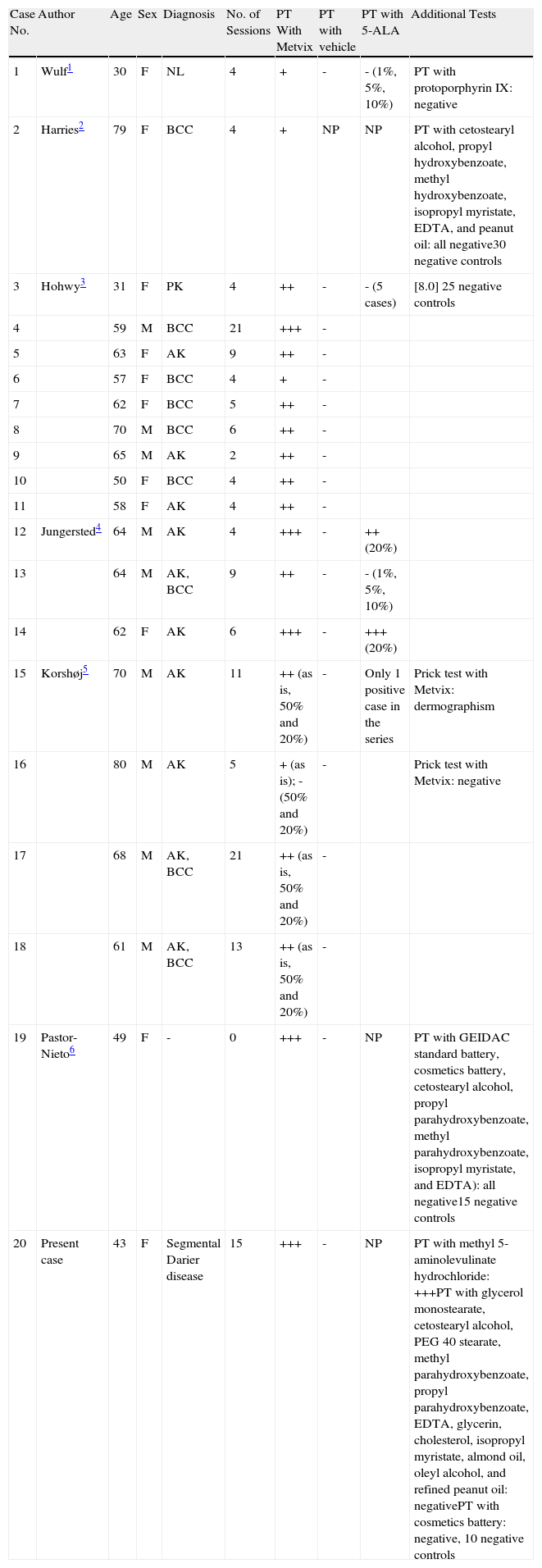To the Editor:
Metvix cream (Laboratorios Galderma S.A.) contains methyl aminolevulinate (MAL, methyl 5-amino-4-oxo-pentanoate, Chemical Abstract Service number 33320-16-0), a methyl ester derivative of aminolevulinic acid (ALA), and 14 excipients (Table 1).
Excipients of Metvix Cream.
| Self-emulsifying glycerol monostearate |
| Cetostearyl alcohol |
| PEG 40 stearate |
| Methyl parahydroxybenzoate |
| Propyl parahydroxybenzoate |
| Disodium edetate |
| Glycerin base |
| White soft paraffin |
| Cholesterol |
| Isopropyl myristate |
| Almond oil |
| Oleyl alcohol |
| Refined peanut oil |
| Purified water |
It is used topically in photodynamic therapy (PDT) for treating various types of nonmelanoma skin cancer. The procedure involves application of the cream under occlusion for 3hours followed by exposure to red light.
We report a new case of allergic contact dermatitis to MAL in a patient with segmental Darier disease treated with PDT and review the literature.
Our patient was a 43-year-old woman with segmental Darier disease on the lateral aspect of the trunk who had been on treatment with PDT for 2 years. After receiving the fifteenth session she presented with erythematous plaques confined to the area of application of Metvix (Fig. 1).
Erythematous, edematous rash with a linear distribution on the lateral aspect of the trunk, limited to the area treated with methyl aminolevulinate cream. There are macular lesions of residual postinflammatory hypopigmentation secondary to segmental Darier disease. The distribution follows the Blaschko lines.
Patch tests were performed with standard batteries of the Spanish Contact Dermatitis and Skin Allergy Research Group (GEIDAC), cosmetics, Metvix (MAL 160mg/g [16%] cream for topical use) as is, and the individual components supplied by the manufacturer. The patches were removed after 48hours and the reactions were read on days 2, 4, and 7. Positive results (+++) were obtained only with Metvix as is and with the active ingredient supplied by the manufacturer (MAL hydrochloride). The tests performed with both substances in 10 controls were negative.
The patient was diagnosed with allergic contact dermatitis to MAL hydrochloride. Treatment with MAL-PDT was continued because of its effectiveness, with a relatively good tolerance of the reactions that occurred and a satisfactory response to treatment with topical corticosteroids.
DiscussionIncluding the present case, there have been 20 reports of allergic contact dermatitis to MAL (Table 2).1–6 Of these cases, 11 were women (55%) and 9 men (45%). The mean age was 59.25 years (range, 30-80 years).The indications for treatment were actinic keratosis (7 patients, 35%), basal cell carcinoma (6 patients, 30%), actinic keratosis and basal cell carcinoma (3 patients, 15%), necrobiosis lipoidica (1 patient, 5%), porokeratosis (1 patient, 5%), and segmental Darier disease (1 patient, 5%).
Cases of Allergic Contact Dermatitis to Methyl Aminolevulinate Described in the Literature.
| Case No. | Author | Age | Sex | Diagnosis | No. of Sessions | PT With Metvix | PT with vehicle | PT with 5-ALA | Additional Tests |
| 1 | Wulf1 | 30 | F | NL | 4 | + | - | - (1%, 5%, 10%) | PT with protoporphyrin IX: negative |
| 2 | Harries2 | 79 | F | BCC | 4 | + | NP | NP | PT with cetostearyl alcohol, propyl hydroxybenzoate, methyl hydroxybenzoate, isopropyl myristate, EDTA, and peanut oil: all negative30 negative controls |
| 3 | Hohwy3 | 31 | F | PK | 4 | ++ | - | - (5 cases) | [8.0] 25 negative controls |
| 4 | 59 | M | BCC | 21 | +++ | - | |||
| 5 | 63 | F | AK | 9 | ++ | - | |||
| 6 | 57 | F | BCC | 4 | + | - | |||
| 7 | 62 | F | BCC | 5 | ++ | - | |||
| 8 | 70 | M | BCC | 6 | ++ | - | |||
| 9 | 65 | M | AK | 2 | ++ | - | |||
| 10 | 50 | F | BCC | 4 | ++ | - | |||
| 11 | 58 | F | AK | 4 | ++ | - | |||
| 12 | Jungersted4 | 64 | M | AK | 4 | +++ | - | ++ (20%) | |
| 13 | 64 | M | AK, BCC | 9 | ++ | - | - (1%, 5%, 10%) | ||
| 14 | 62 | F | AK | 6 | +++ | - | +++ (20%) | ||
| 15 | Korshøj5 | 70 | M | AK | 11 | ++ (as is, 50% and 20%) | - | Only 1 positive case in the series | Prick test with Metvix: dermographism |
| 16 | 80 | M | AK | 5 | + (as is); - (50% and 20%) | - | Prick test with Metvix: negative | ||
| 17 | 68 | M | AK, BCC | 21 | ++ (as is, 50% and 20%) | - | |||
| 18 | 61 | M | AK, BCC | 13 | ++ (as is, 50% and 20%) | - | |||
| 19 | Pastor-Nieto6 | 49 | F | - | 0 | +++ | - | NP | PT with GEIDAC standard battery, cosmetics battery, cetostearyl alcohol, propyl parahydroxybenzoate, methyl parahydroxybenzoate, isopropyl myristate, and EDTA): all negative15 negative controls |
| 20 | Present case | 43 | F | Segmental Darier disease | 15 | +++ | - | NP | PT with methyl 5-aminolevulinate hydrochloride: +++PT with glycerol monostearate, cetostearyl alcohol, PEG 40 stearate, methyl parahydroxybenzoate, propyl parahydroxybenzoate, EDTA, glycerin, cholesterol, isopropyl myristate, almond oil, oleyl alcohol, and refined peanut oil: negativePT with cosmetics battery: negative, 10 negative controls |
AK, actinic keratosis; ALA, aminolevulanic acid; BCC, basal cell carcinoma; EDTA, disodium edetate; F, female; GEIDAC, Spanish Contact Dermatitis and Skin Allergy Research Group; M, male; NL, necrobiosis lipoidica; NP, not performed; PEG, polyethylene glycol; PK, porokeratosis; PT, patch tests.
The mean number of PDT sessions that patients had received prior to presenting with the dermatitis was 7.55 (range, 2-21 sessions). The condition was considered occupational in only 1 patient, a clinical assistant who worked in a PDT unit.6
Some authors have reported severe reactions with dissemination that occasionally required hospitalization and treatment with systemic corticosteroids.1–3 Others reported less severe, localized reactions.6
Patch tests with Metvix as is were positive in all patients and, in the 19 patients who underwent them, patch tests with the vehicle were negative. In none of the cases reported previously had patch tests been performed with pure MAL, so the possibility of a combined sensitization had not been completely ruled out. In our case the positive test with MAL supplied by the manufacturer allows us to attribute the sensitization to the active ingredient. Patch tests were negative in 80 of the controls reported in the literature, including our 10, confirming that the reactions were allergic in nature.
ALA patch tests were positive in only 3 of the 10 cases in which they were performed, so there is no evidence of cross-reactivity between the 2 agents despite their structural similarity.
Korshøj et al.5 determined that the frequency of sensitization to MAL in a group of 20 patients treated with at least 5 sessions of PDT was 35% compared with 1.7% in the control group (P<.0001).
A skin safety test performed in the United States showed that 52% of a group of 58 healthy volunteers became sensitized after exposure to MAL cream applied to the back under occlusion.7
The use of PDT in patients with nonsegmental Darier disease has been reported in 3 cases.8–10Exadaktylou et al.8 reported 5 cases treated with ALA-PDT. All 5 developed erythema and exudation, which were interpreted as an inflammatory response to treatment. Van’t Vesteinde et al.9 described a patient treated with ALA-PDT who developed erythema, edema, and papules in areas previously unaffected by Darier disease. Avery et al.10 reported a patient treated with MAL-PDT who showed a mild, self-limiting inflammatory response.Patch testing was not performed in any of the above cases.
The risk of sensitization to MAL may have been underestimated. Intense inflammatory reactions after PDT, commonly observed in clinical practice, are usually attributed to the mechanism of action of the drug and no patch tests are performed. It is likely that many of these reactions reflect genuine contact dermatitis, so it is advisable to perform patch testing in these cases.
In conclusion, we describe the first case of contact dermatitis to Metvix in which patch tests were performed with pure MAL. For the first time the sensitization can be unequivocally attributed to the active ingredient.
Laboratorios Galderma S.A. are thanked for supplying samples of the vehicle and components of MAL cream for the patch tests.
Please cite this article as: Pastor-Nieto MA, et al. Dermatitis alérgica de contacto a metil aminolevulinato. Actas Dermo-sifiliogr. 2013;104:168–70.









